![]()
![]()
![]()
Use LEFT and RIGHT arrow keys to navigate between flashcards;
Use UP and DOWN arrow keys to flip the card;
H to show hint;
A reads text to speech;
125 Cards in this Set
- Front
- Back
|
Presence or absence of disease; complete physical, mental, social well-being; ability to maintain normal roles; able to adapt;
|
Health
|
|
|
State of well-being; Basic Aspects are: self-responsibility, an ultimate goal, a dynamic growing process, daily decision making related to health, whole being of an individual
|
Wellness
|
|
|
Subjective perception of vitality and feeling well; described objectively, experienced, measured; can be plotted on a continuum
|
Well-being
|
|
|
What Dimension of Wellness is this?: Ability to carry out daily tasks; achieve fitness;practice positive lifestyle habits
|
Physical Dimension
|
|
|
What Dimension of Wellness is this?: Interact successfully with people, develop and maintain intimacy with significant others, develop respect for others
|
Social Dimension
|
|
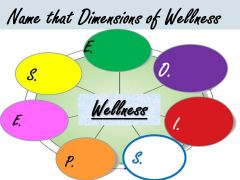
|

|
|
|
What Dimension of Wellness is this?: Ability to manage stress; ability to EXPRESS EMOTIONS appropriately, Ability to recognize, accept, and express feelings
|
Emotional Dimension
|
|
|
What Dimension of Wellness is this?: Ability to learn; Ability to use information effectively; Striving for continued growth and learning
|
Intellectual Dimension
|
|
|
What Dimension of Wellness is this?: Belief in some force that serves to unite humans; provide meaning to life; provide purpose to life; includes personal morals, values, and ethics
|
Spiritual Dimension
|
|
|
What Dimension of Wellness is this?: Ability to achieve balance between work and leisure
|
Occupational Dimension
|
|
|
What Dimension of Wellness is this?: Ability to promote health measures that improves: standard of living and quality of life
|
Environmental Dimension
|
|
|
The narrowest interpretation of health; People viewed as physiologic systems with related functions; HEALTH IS state of not being "sick"
|
Model of Health : Clinical Model
|
|
|
HEALTH IS defined in terms of individual's ability to fulfill societal roles; Sickness is the inability to perform one's work role
|
Model of Health: Role Performance Model
|
|
|
Sister Callista Roy(1999); views person as adaptive system; HEALTH IS a creative process; disease is a failure in adaptation or maladaption
|
Model of Health: Adaptation Model
|
|
|
Pender (2006);HEALTH IS a condition of actualization or realization of a person's potential. Actualization is the apex (Maslow); Illness is a condition that prevents self-actualization
|
Model of Health: Eudemonistic Model
|
|
|
Dunn's High-Level Wellness Grid (1959)
Travis's Illness-Wellness Continuum (2004) 4+ Model of Wellness (2001) |
Model of Health: Health-Illness Continua
|
|
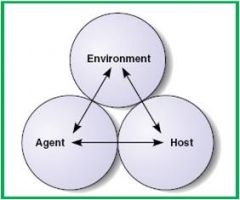
Leavell and Clark (1965); "ecologic model"; used primarily in predicting illness; Constantly affecting each other; In Balance = Health; Out of Balance = Disease
|
Model of Health: Agent-Host-Environment
|
|
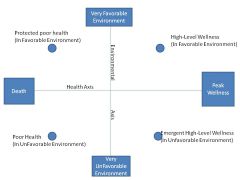
Demonstrates the interaction of the environemtn with the illness-wellness continuum; four quadrants of health and wellness
|
Model of Health: Health Illness Continua:
Dunn's High-Level Wellness Grid |
|

Movement to the right of the neutral point indicates increasing levels of health and well-being achieved thru: 1) awareness 2) education 3) growth; movement to the left of the neutral point indicates progressively decreasing levels of health
|
Model of Health: Health- Illness Continuum:
Travis's Illness-Wellness Continuum |
|
|
Baldwin and Conger (2001); consists of the four domains of inner self (physical, spiritual, emotional, and intellectual) PLUS the elements of the outer systems (environment, culture, safety, etc.)
|
Model of Health: Health-Illness Continua:
4+ Model of Wellness |
|
|
Biologic Dimension (genetic makeup, gender, age, developmental level);
Psychologic Dimension ("emotional factors", Mind-Body interactions, self-concept); Cognitive Dimension ("Intellectual factors", Lifestyle choices, spiritual/religious beliefs) |
Internal Variables Influencing Health Status
|
|
|
Environment
Standards of Living Family and Cultural Beliefs Social Support Networks |
External Variables Influencing Health Status
|
|
|
Measurable concept that can be used to predict which people are most likely to change their behavior; People who believe that they have major influence on their own health status = internals; People who believe their health is largely controlled by outside forces = externals
|
Health Belief Model: Locus of Control Model
|
|
|
Individual perceptions (perceived susceptibility to disease and perceived seriousness of disease)
Modifying factors(demographic variables; socio-psychologic variables; structural variables; cues to action) Cues to action(mass media campaigns; advice from others; reminders for healthcare provider; illness of family/friend; articles in magazine/newspaper) |
Health Belief Model: Rosenstock and Becker's Model
|
|
|
Highly personal state; person's physical, emotional, intellectual, social, developmental, or spiritual functioning is thought to be diminished; not synonymous with disease; Subjective
|
Illness
|
|
|
Alteration in body functions resulting in a reduction of capacities or a shortening of the normal life span
|
Disease
|
|
|
Characterized by severe symptoms of relatively short duration; Symptoms often APPEAR ABRUPTLY, subside quickly; May or may not require intervention by health care professionals; Most people return to normal level of wellness
|
Acute Illness
|
|
|
Lasts for an extended period; Usually has a slow onset; Often have periods of remissions and exacerbations; Care includes promoting independence, sense of control, and wellness; Learn how to live with physical limitations and discomfort
|
Chronic Illness
|
|
|
Clients are: not held responsible for their condition; not excused from certain social roles and tasks; obligated to try to get well as quickly as possible; obligated to seek competent help
|
Parson's Four Aspects of the Sick Role (1979)
|
|
|
1) Symptom Experiences
2) Assumption of the Sick Role 3) Medical Care Contact 4) Dependent Client Role 5) Recovery/Rehabilitation |
Suchman's 5 Stages of Illness (1979)
|
|
|
Clients may experience:
Behavioral and Emotional changes Loss of Autonomy Self-Concept and Body Image changes Lifestyle Changes |
Impact of Illness on Client
|
|
|
Client Families may experience:
Role changes Task Reassignments Increased demands on time Anxiety about outcomes Conflict about responsibilities Financial Problems Lonelieness Depending on: which member is ill, seriousness and length of illness, and cultural and social customs family follows |
Impact of Illness on Client's Family
|
|
|
involuntary process that occurs when people adapt to or borrow traits from another culture. Member of the nondominant cultural group often forced to learn the new culture to survive; changing one's cultural patterns to those of the host society
|
Acculturation
|
|
|
Process by which an individual develops a new cultural identity and becomes like the members of the dominant culture. Encompasses behavioral, marital, identification, and civic aspects; Conscious effort
|
Assimilation
|
|
|
Used to describe a person who crosses two cultures, lifestyles, and sets of values
|
Bicultural
|
|
|
Concept that describes the provision of nursing care across cultural boundaries and takes into account the context in which the client lives and the situations in which the client's health problems arise
|
Cultural Care
|
|
|
Application of underlying background knowledge that must be possessed to provide a given client with the best possible health care
|
Culturally appropriate
|
|
|
Within the delivered care the nurse understands and attends to the total context of the client's situation and uses a complex combination of knowledge, attitudes, and skills
|
Culturally Competent
|
|
|
Care that demonstrates basic knowledge of and constructive attitudes towards the health traditions observed among the diverse cultural groups found in the setting
|
Culturally Sensitive
|
|
|
A world view and set of traditions used and transmitted from generation to generation by a particular group, includes related attitudes and institutions; nonphysical traits such as values, beliefs, attitudes, and customs shared by a group of people
|
Culture
|
|
|
A disorder that occurs in response to transition from one cultural setting to another
|
Culture Shock
|
|
|
Usually composed of people who have a distinct identity and yet are related to a larger cultural group
|
Subculture
|
|
|
The differential treatment of individuals or groups
|
Discrimination
|
|
|
Assuming that all members of a culture or ethnic group are alike
|
Stereotyping
|
|
|
A negative belief or preference that is generalized about a group and that leads to "prejudgment"
|
Prejudice
|
|
|
The fact or state of being different
|
Diversity
|
|
|
Belonging to a specific group of individuals who share a common social and cultural heritage
|
Ethnic
|
|
|
Classification of people according to shared biologic characteristics and physical features
|
Race
|
|
|
(Estes and Zitzow) The degree to which one's lifestyle reflects his or her respective tribal culture
|
Heritage Consistancy
|
|
|
The observance of the beliefs and practices of one's acculturated belief system
|
Heritage Inconsistency
|
|
|
Holds that the forces of nature must be maintained in balance or harmony; when natural balance is disturbed the illness results; humans are one aspect of nature
|
Holistic Health Belief
|
|
|
Beliefs and practices relating to illness prevention and healing that derive from cultural traditions rather than from modern medicine's scientific base; more humanistic than biomedical; less expensive; frequently requires ritual; often more comfortable and less frightening
|
Folk Medicine
|
|
|
A belief system in which people attribute the fate of the world and those in it to the actions of God, the gods, or other supernatural forces for good or evil
|
Magico-Religious Health Belief
|
|
|
Based on the belief that life and life processes are controlled by physical and biochemical processes that can be manipulated by humans; illness is caused by germs, bacteria, or a breakdown of the human machine; pills, treatments or surgery will cure
|
Biomedical Health Belief
OR Scientific Health Belief |
|
|
One's acculturated belief system; the opposite of traditional
|
Modern
|
|
|
Observance of the beliefs and practices of one's heritage cultural belief system
|
Traditional
|
|
|
An individual who mediates spoken communication between people speaking different languages without adding, omitting, or distorting meaning or editorializing
|
Interpreter
|
|
|
A person who converts written material (such as patient education pamphlets) from one language into another
|
Translator
|
|
|
Things passed down from previous generations (non tangible)
|
Heritage
|
|
|
Values
Beliefs Attitudes Customs All shared by a group of people and passed on from generation to generation |
Culture
|
|
|
Skin Color
Gender Age Appearance Body Language |
Five aspects of First Impressions
|
|
|
Formal area of study and practice focused on comparative human-care differences and similarities of the beliefs, values, and patterned life ways of cultures to provide culturally congruent, meaningful, and beneficial health care to people
|
Trans-cultural Nursing (Madeleine Leininger, 1950)
|
|
|
Fear or Dislike of people different from one's self
|
Xenophobia
|
|
|
Belief that one's own culture or way of life is better than that of others
|
Ethnocentric
|
|
|
“The degree to which one’s lifestyle reflects his or her respective tribal culture”
Overlapping components: Culture Ethnicity Religion Socialization |
Heritage Consistency (Zitzow and Estes 1981)
|
|
|
Predicated on the concept of holistic health and describes what people do from a traditional perspective to maintain, protect, and restore health of mind, body and spirit.
|
Health Traditions Model (Spector, 2004)
|
|
|
Together with biomedical treatment
|
Complementary
|
|
|
In place of biomedical treatment
|
Alternative
|
|
|
CAM
|
Complementary and Alternative Medicine
|
|
|
"hot" foods or foods that are hot in temperature will be used to treat "cold" illnesses
|
Nutritional Patterns of Cultural Nursing Care
|
|
|
Avoid meats on Ash Wednesday and Good Friday
|
Roman Catholics
|
|
|
Prohibits meat, tea, coffee, or alcohol
|
Some Protestant faiths
|
|
|
Prohibit the ingestion of Pork or Pork Products
|
Orthodox Judaism and Islam
|
|
|
Observe Kosher customs, eating certain foods only if they have been inspected by a rabbi and prepared according to dietary laws
|
Orthodox Judaism
|
|
|
Strict Vegetarians
|
Some Buddhists, Hindus and Sikhs
|
|
|
An assessment and educational tool that indicates a client's risk for disease or injury during the next 10 years by comparing the client's risk with the mortality risk of the corresponding age, sex, and racial group
|
Health Risk Assessment (HRA)
|
|
|
(NANDA) "describes human responses to levels of wellness in an individual, family, or community that have a readiness for enhancement"; can be applied at all levels of prevention but are particularly useful for healthy clients who require teaching for health promotion, disease prevention, and personal growth; preceded by the modifier “readiness for enhanced"
|
Wellness Diagnosis
|
|
|
Any activity undertaken for the purpose of achieving a higher level of health and well-being; Not disease oriented; Motivated by personal, positive “approach” to wellness
|
Health Promotion
|
|
|
Behavior motivated by a desire to actively avoid illness, detect it early, or maintain functioning within the constraints of illness; Illness or injury specific; Motivated by avoidance of illness
|
Health Protection
|
|
|
Activities directed toward the protection from or avoidance of potential health risks; Immunizations, risk assessment for specific disease, family planning, environmental sanitation, adequate housing- recreation- work conditions; Health Promotion/Protection; Decrease risk or exposure of individual/community to disease
|
Primary Prevention
|
|
|
Activities designed for early diagnosis and treatment of disease or illness, designed to restore disabled individuals to their optimal level of functioning; SCREENINGS, encouraging medical and dental checkups,assessing G&D of children
|
Secondary Prevention
|
|
|
Begins after an illness or disability is fixed, stabilized or determined to be irreversible; Rehab,support group, teaching to identify and prevent complications; focuses on restoration
|
Tertiary prevention
|
|
|
A person typically denies having a problem, views others as having a problem and therefore wants to change the other person's behavior
|
Pre-contemplation stage
|
|
|
The person acknowledges having a problem, seriously considers changing a specific behavior, actively gathers information, and verbalizes plans to change the behavior in the near future
|
Contemplation stage
|
|
|
Occurs when the person undertakes cognitive and behavioral activities that prepare the person for change
|
Preparation stage
|
|
|
Occurs when the person actively implements behavioral and cognitive strategies to interrupt previous behavior patterns and adopt new ones; this stage requires the greatest commitment of time and energy
|
Action stage
|
|
|
The person integrates newly adopted behavior patterns into his or her lifestyle
|
Maintenance Stage
|
|
|
The ultimate goal where the individual has complete confidence that the problem is no longer a temptation or threat
|
Termination Stage
|
|
|
A unique being who is different from every other human being with a different combination of genetics, life experiences, and environmental interactions.
|
Individual/Individuality
|
|
|
The nurse considers all the principles and areas that apply when taking care of any client of that age and condition
|
Total Care Context
|
|
|
The nurse becomes acquainted with the client as an individual, using the total care principles that apply to this person at this time
|
Individualized Care Context
|
|
|
Concerned with the individual as a whole, not as an assembly of parts; Spiritual, emotional and physical health are interrelated; Strive to understand how one area of concern relates to the whole person; Consider the relationship of individuals to the environment and to others
|
Holism (Cannon 1939)
|
|
|
The relative constancy of the internal process of the body, such as blood oxygen and carbon dioxide levels, blood pressure, body temp, blood glucose, and fluid and electrolyte balance; the tendency of the body to maintain a state of balance or equilibrium while continually changing
|
Homeostasis (Cannon 1930)
|
|
|
The internal environment of the body is relatively stable and constant.
Main Characteristics: Self-regulatory (automatic) Compensatory (counterbalancing abnormalities) Tend to be regulated by negative feedback systems Require several feedback mechanisms to correct only one physiologic imbalance |
Physiologic Homeostasis
|
|
|
Refers to emotional or psychologic balance or a state of mental well-being. Prerequisites are:
Stable physical environment Stable psychological envrionment Social environment that includes adults who are healthy role models Life experience that provides satisfaction |
Psychologic Homeostasis
|
|
|
Maslow(1970)
Kalish (1983)http://www.flashcardexchange.com/mycards/list/1758138 |
Need Theorists
|
|
|
Realistic, sees life clearly, and is objective
Judges people correctly Has superior perception, is more decisive Has clear notion of right and wrong Is usually accurate in predicting future events Understands art, music, politics, and philosophy Possesses humility, listens carefully Is open to new ideas Is self-confident and has self-respect Is highly independent, desires privacy Can appear remote and detached |
Maslow's Characteristics of the Self-Actualized Person
|
|
|
"Increasing quality and years of healthy life" indicates the aging or "graying" of the population
"Eliminate health disparities" reflects the diversity of the population |
Two major goals of Healthy People 2010
|
|
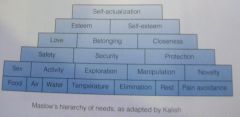
|
Kalish's Hierarchy of Needs
Second category = Stimulation Needs |
|

|
Maslow's Heirarchy of Needs (1970)
|
|
|
Competence or approach oriented model
Motivational source for behaviour changes based on individual's subjective value of the change |
Health Promotion Model (HPM)
|
|
|
Individual Characteristics and experiences (prior behaviors; personal factors)
Behavior specific cognitions and affect(Perceived benefits of action; Percieved barriers to action; percieved self-efficacy; activity-related affect; interpersonal factors; situational influences) Commitment to a plan of action Immediate competing demands and preferences Behavioral outcome |
Variables of Health Promotion Model
|
|
|
Pre-contemplation (does not intend to take action)
Contemplation (acknowledge has problem; intends to change) Preparation (plans to take action; has taken steps) Action (makes observable modifications in lifestyle) Maintenance (strives to prevent relapse; integrates new behavior into lifestyle) Termination (copes without fear of relapse) |
Stages of Health Behavior Change
|
|
|
Model healthy lifestyle
Facilitate client involvement Teach self-care strategies Assist clients to increase levels of health Educate clients to be effective health care consumers Assist clients to develop and choose health-promoting options Guide development of effective problem-solving and decision-making Reinforce clients’ personal and family health-promoting behaviors Advocate in the community for changes that promote a healthy environment |
Nurse's Role in Health Promotion
|
|
|
Basic Unit of society; those individuals who are considered bythe others to represent their significant persons.
|
Family
|
|
|
Basic role is to protect and socialize its members
Protecting physical health Providing an environment conducive to physical growth and health Influencing the cognitive and psychosocial growth of its members Influencing health care practices and coping mechanisms based on family values and beliefs Developing a sense of family purpose & affiliation Adding and socializing new members Providing & distributing care and services to its members |
Roles and Functions of the Family
|
|
|
Nuclear
Extended family Traditional Two-career Single parent Adolescent Foster Blended Intra-generational Cohabiting Gay and lesbian Single adults living alone Immediate |
Types of Families
|
|
|
Parents and their offspring
|
Nuclear family
|
|
|
Relatives of nuclear family (aunts, uncles, grandparents)
|
Extended Family
|
|
|
Both parents reside in the home with their children; Mother assumes nurturing role; Father assumes provider role
|
Traditional Family
|
|
|
Both partners are employed; may or may not have children
|
Two-Career
|
|
|
Death of a spouse; separation; divorce; birth of a child to an unmarried woman; adoption of a child by a single man or woman
|
Single-Parent Family
|
|
|
Parents often developmentally, physically, emotionally, and financially ill prepared to undertake the responsibility of parenthood. Rates highest among black teens, Hispanic and then white.
|
Adolescent Family
|
|
|
Children who can no longer live with their birth parents and placed within another temporarily
|
Foster Family
|
|
|
Existing family units who join together to form new families
|
Blended Family
OR Step Family or Reconstituted Family |
|
|
More than two generations living together
|
Intra-generational Family
|
|
|
Consist of unrelated individuals or families who live under one roof
|
Cohabiting Family
|
|
|
Based on the same goals of caring and commitment seen in heterosexual relationships; include step families and single-parent families
|
Gay and Lesbian Family
|
|
|
Include young self-supporting adults who have recently left the nuclear family as well as older adults on their own
|
Single Adults Living Alone
|
|
|
Children no longer at home
|
Immediate Family
|
|
|
Addresses membership and relationships (Structural)
Examines effects of relationships on family and other systems(Functional) |
Structural-Functional Theory
|
|
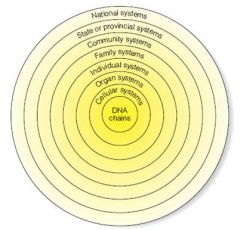
Family Unit is an Open System; Continually interacting with and influenced by other systems; Boundaries regulate input/output
|
Systems Theory
Common System Hierarchy(image) |
|
|
Family Structure (Size/Type/Age)
Family Roles and Functions(Who works/household roles) Physical Health Status(of each member) Interaction Patterns (ways of expressing emotions) Family Values(cultural/religious orientation) Coping Resources(Financial status, methods of coping) |
Family Health Assessment Areas
|
|
|
Maturity
Heredity Gender or Race Sociologic Lifestyle |
Family Heath Risk Factors
|
|
|
Nature of the illness (mild to severe)
Duration of the illness (short to long) Residual effects (none to permanent disability) Meaning and significance to family Financial impact of the illness Effect of illness on future family functioning (alteration of family members’ roles and tasks) |
Factors Determining Impact of Illness on the Family
|

